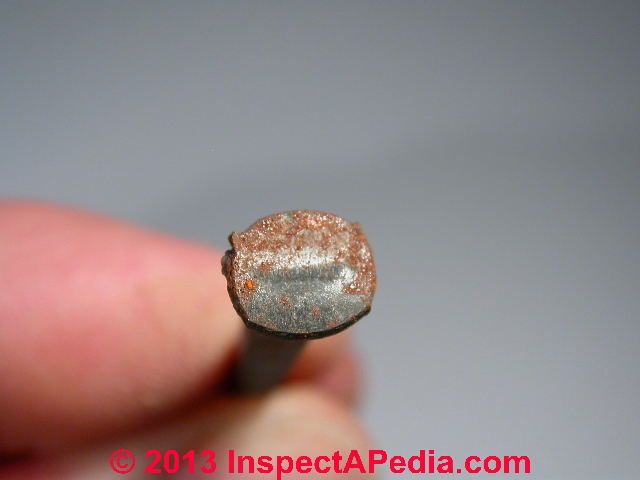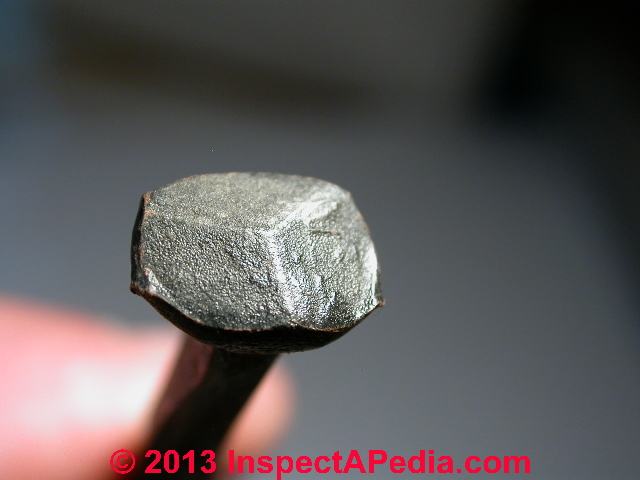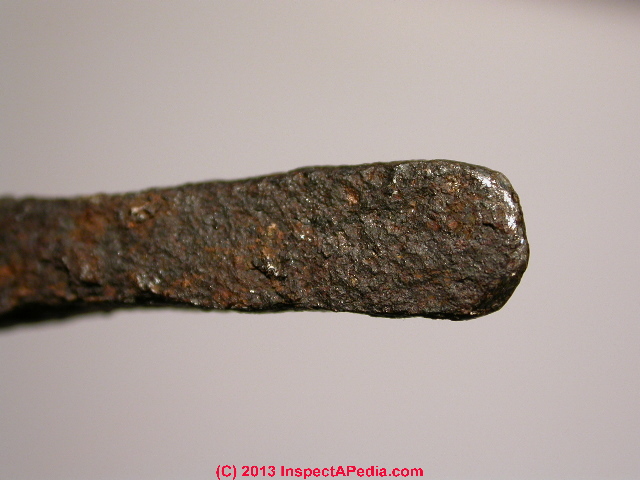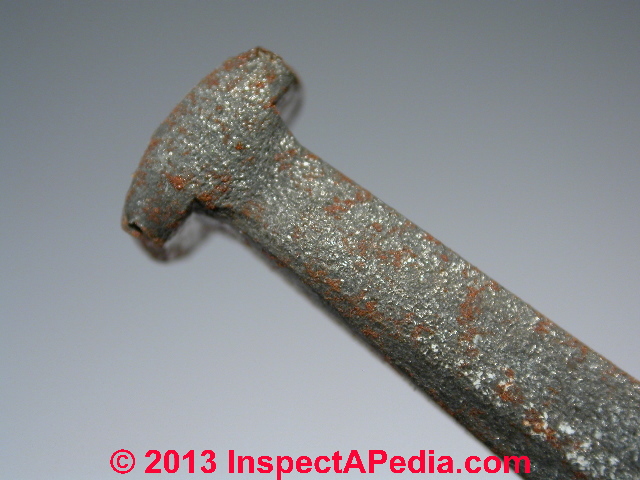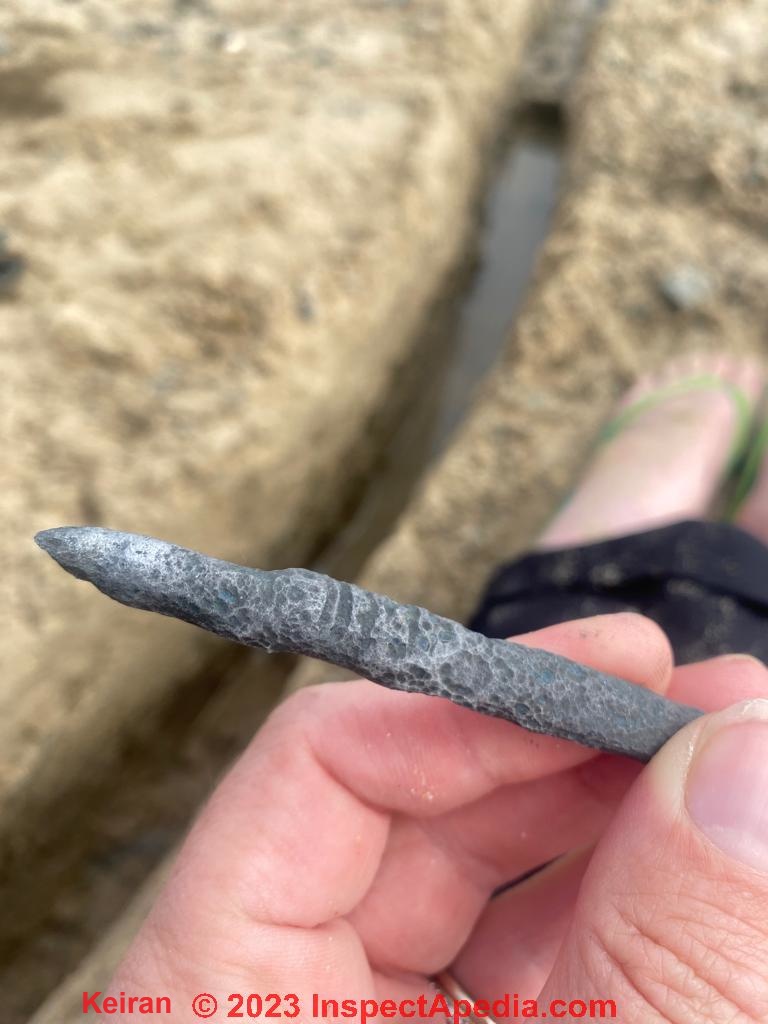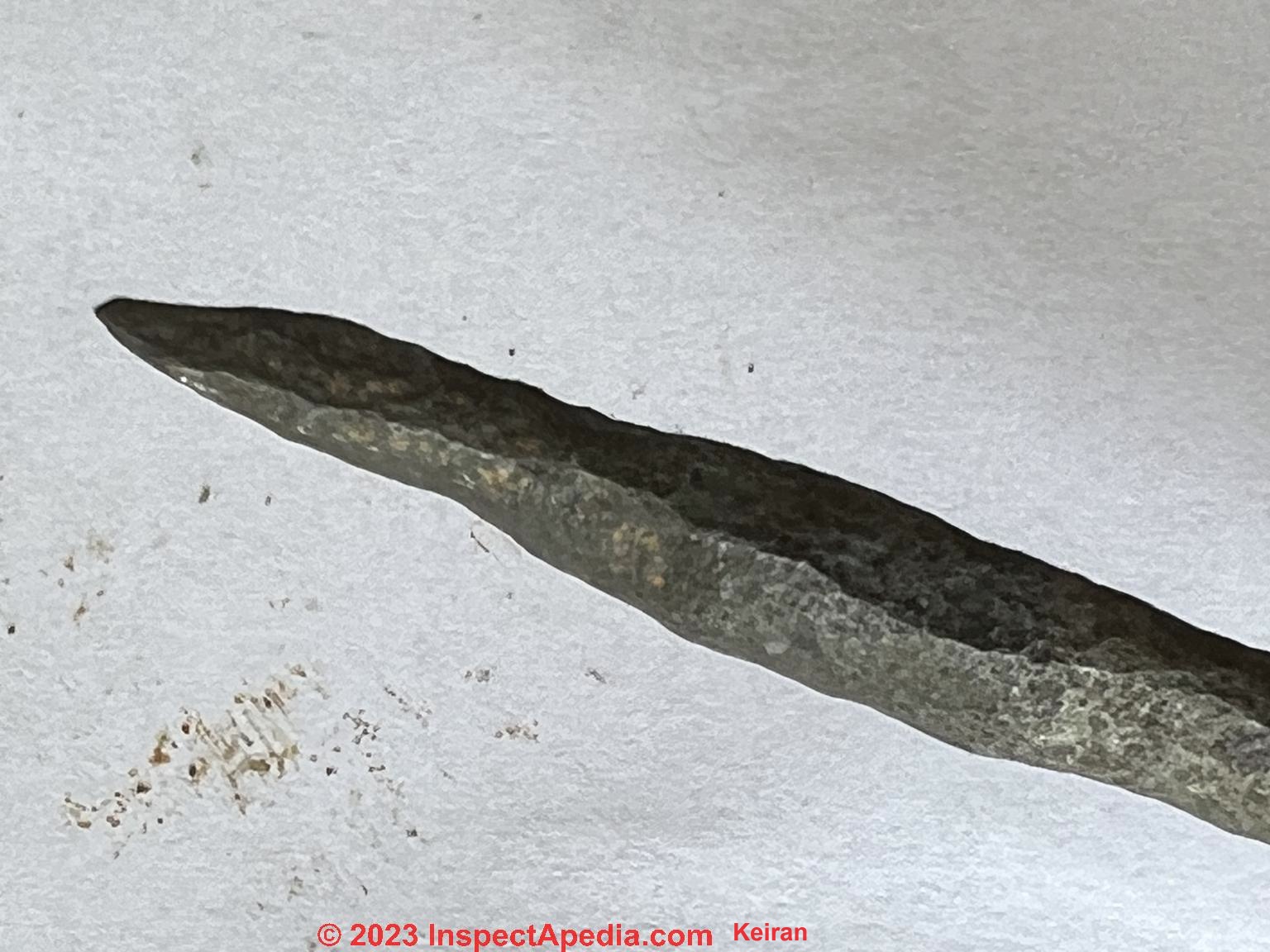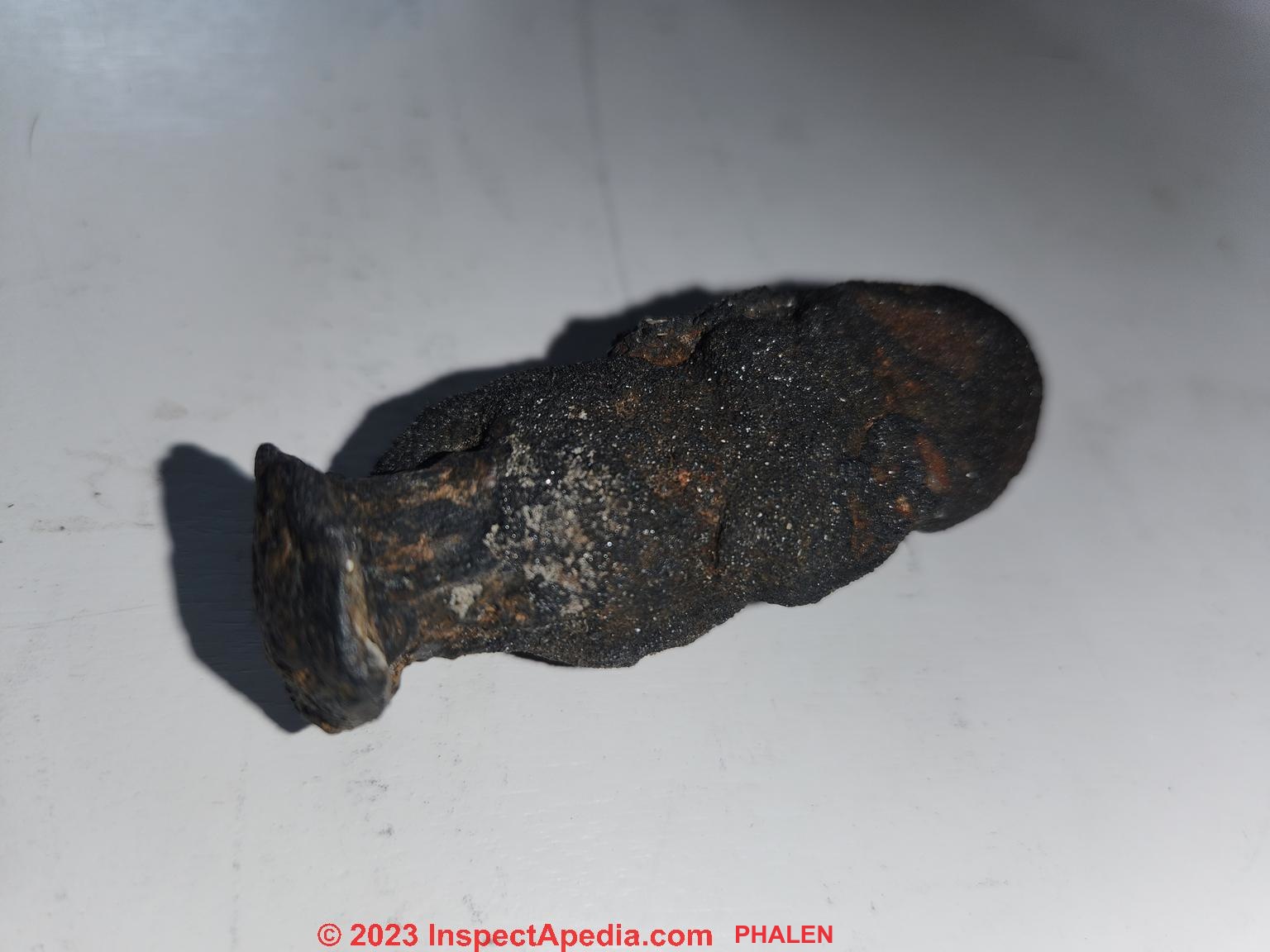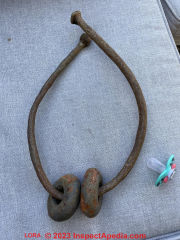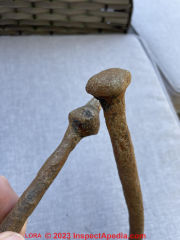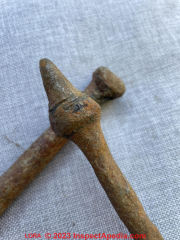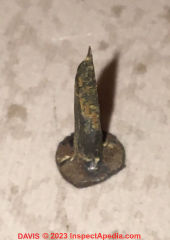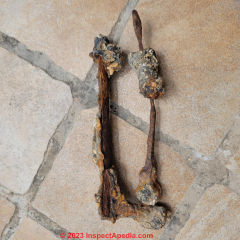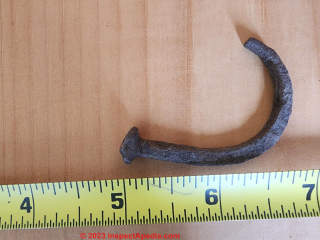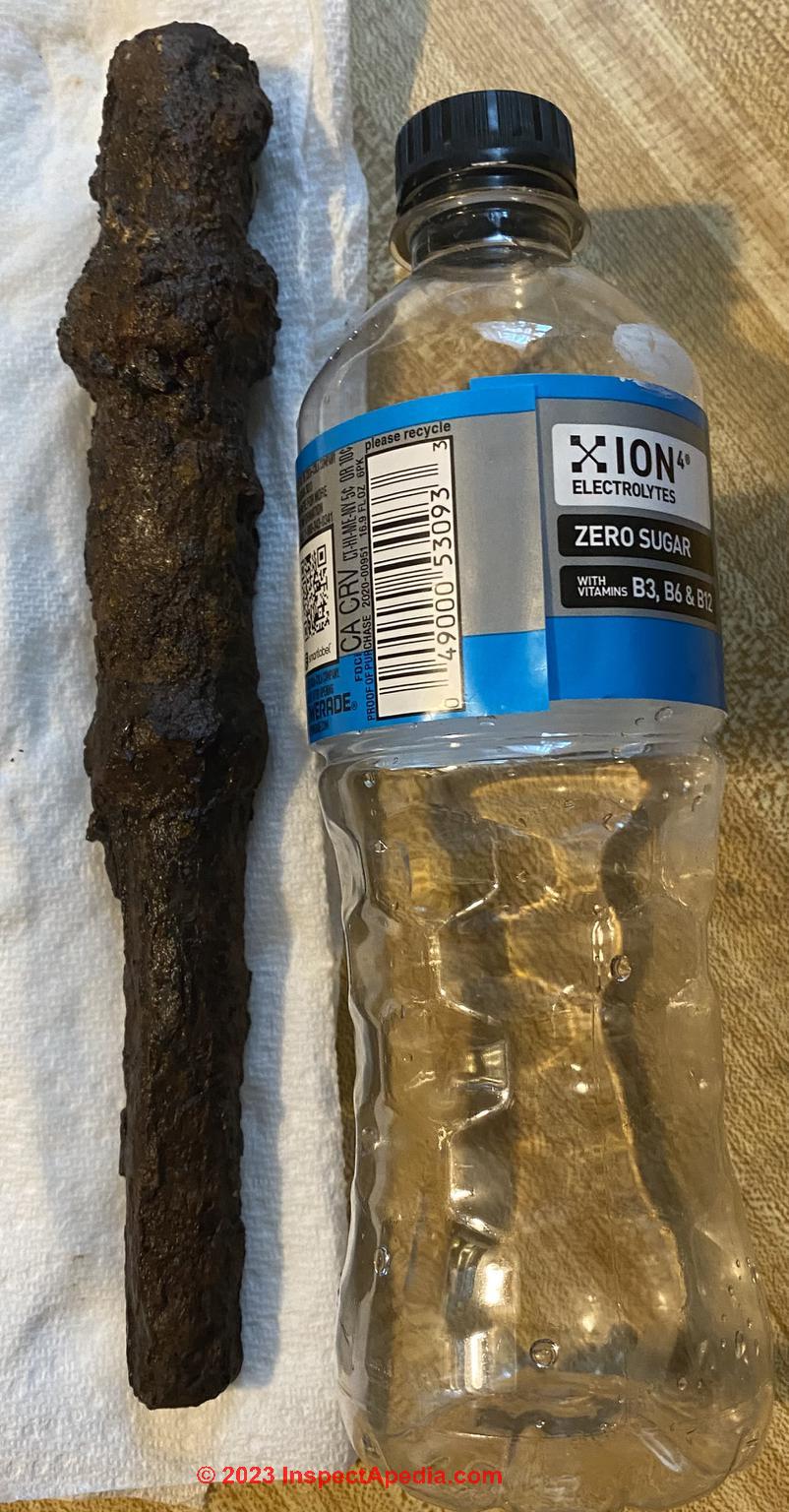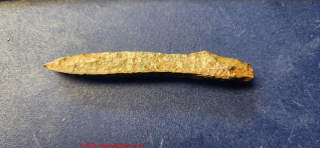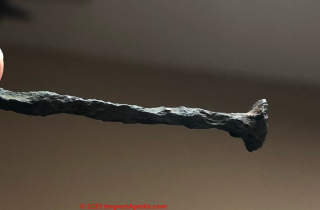 Key to Age of Antique Metal Nails
Key to Age of Antique Metal Nails
Context, Head, Shank, Details Help ID Age a Nail
- POST a QUESTION or COMMENT about determining age of antique hardware
Easy questions help form a guess at the plausible age of various types of antique & modern nails, including wood treenails, hand-wrought nails, cut nails, wire nails.
This article series describes antique and modern cut nails focusing on tree nails, wrought nails, and cut nails used in wood frame construction or interior finishing or carpentry work. It includes useful dates for the manufacture of different nail types.
InspectAPedia tolerates no conflicts of interest. We have no relationship with advertisers, products, or services discussed at this website.
- Daniel Friedman, Publisher/Editor/Author - See WHO ARE WE?
Guess the Age of Nails & Building Hardware
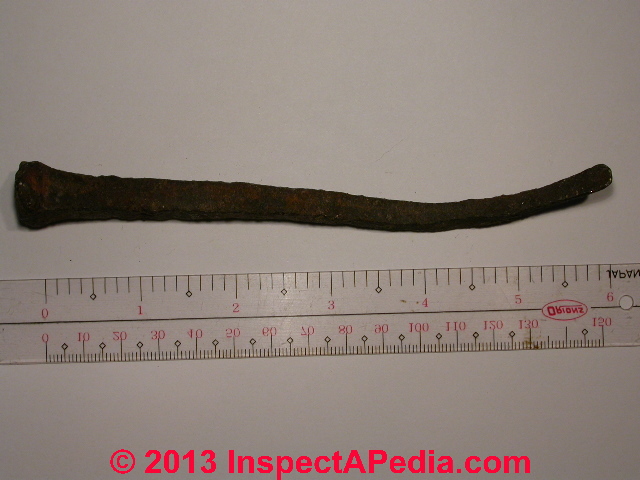 A physical examination of old or antique nails and fasteners and other building hardware combined with questions about the country, city, and building or other location where the nails were found can offer clues to the probable age and original purpose of the old nail or spike.
A physical examination of old or antique nails and fasteners and other building hardware combined with questions about the country, city, and building or other location where the nails were found can offer clues to the probable age and original purpose of the old nail or spike.
The earliest known nails date from at least 300 B.C.
The earliest-date of different styles of nails, hand-wrought nails, cut nails, machine cut nails, and machine made round or wire nails depends on the country where the nails were manufactured and for large countries like Australia, the U.S. or Canada, also on the spread of nail making equipment across the country.
Article of Contents:
In our home page for this topic we note:
Nelson (NPS) and other nail chronologists point out, however that a wealth other details can describe the date of production and use of each of those three general nail types. In turn, nail details can establish the time of original construction of a building and the time of modifications to the structure.
Watch out: experts warn that examination of old nails, used with discretion, has proved useful and reliable as a technique for estimating the age of a building (Nelson 1988 US NPS).
- No single nail should be used to guess the age of a building, ship, or other item
- You need a sufficient number of nail samples
- You need to determine if the entire building was built at one time or if it is comprised of multiple constructions built at different times
- Other contextual clues must be considered when guessing at the age of a nail or guessing at the age of a building, boat, ship, or other item built using the nail, such as the location where the nail was found, the history of that site, what industries or activities occurred there, and
- In addition to nails themselves, consider building material, wood saw cut marks, and other hardware details that further assist in determining building age.
...
Antique Nail & Spike Aging Questions and Inspection Points
1: Nail / Spike Location
Where was the nail, spike, tack found: Country, city, building, lake, river or stream
For example the the first mass produced nails appeared in Europe in the 1400s; The First Nail Making Machines appeared in Europe around 1590 as Slitting Mills.
Keep in mind that nails were often imported from one area to another. For example in North America nails were imported to the Colonies from Europe. So you may find a machine made nail in an area where there was no nail making machinery at all.
1775-1783 American Revolution: American colonists shifted to local production of nails and nail import from England was reduced.
2. Age of nail's surrounding materials - contextual information
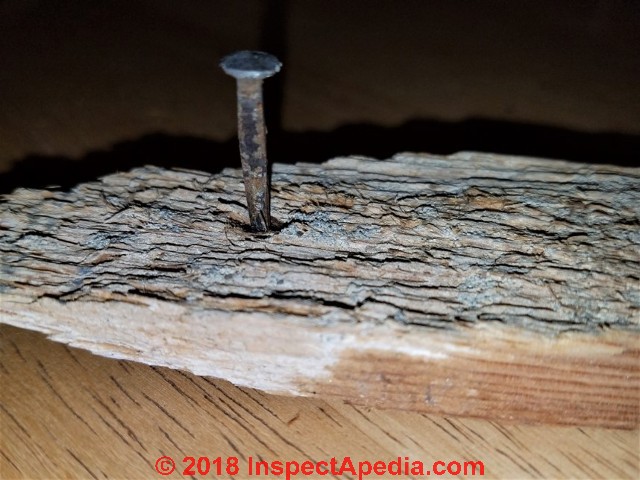 If the nail was found in a building, what is the age of the building and when were renovations or additions made to the building?
If the nail was found in a building, what is the age of the building and when were renovations or additions made to the building?
Also what type of building was it: home, barn, commercial structure, deck, wharf, ship, boat, or even an antique aircraft?
What is the history of the area where the nail or spike was found? See our examples below
at ANCIENT ROMAN NAILS
at INVERNESS CANAL IRON TOOLS & SPIKES
and at ESOPUS MEADOWS LIGHTHOUSE ISLAND SPIKE - using historical context of surroundings to guess the purpose and age of iron nails artifacts.
Take a look at this little antique cut-nail - it's twisted so you may be fooled but this is a machine made but small cut nail.
Look at where it's found: this is a strip of wood lath.
So we can be pretty sure that this is a lath nail. The increase in width below the cut nail head followed again by decrease tells us something about the manner in which this cut nail was sliced from the iron blank and thus more about its age, as we'll explain below.
Now if this lath scrap is, for example, from an old house I restored at 28 West St. in Wappingers Falls NY (known as "the bleachery") we know when that house was built and thus we can make a pretty good guess that original wood lath in the home dates from around the U.S. Civil War, perhaps 1865 to about 1880.
Incidentally if you look closely you'll see the saw cut kerf marks faintly visible on this wood lath.
More help: SAW & AXE CUTS, TOOL MARKS, AGE
After making what use you can of surrounding mud, dirt, debris to understand the nail's context and history, get the crud off to get a better look at the nail.
Also see NAIL & HARDWARE CLEAN-UP
Also see RAILROAD SPIKE AGE - CONTEXTUAL CLUES
3. Nail Application or Use
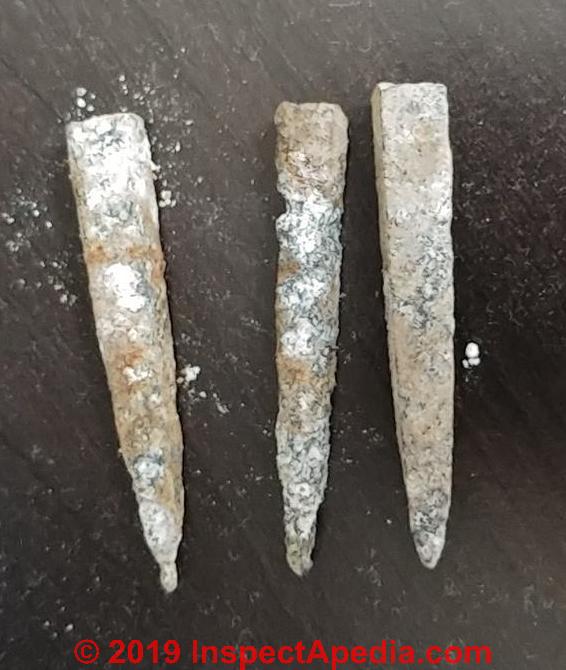 Earliest hand-wrought spikes and nails appeared principally in wood frame construction; later nails were also used for decorative purposes, nailed in patterns, for example.
Earliest hand-wrought spikes and nails appeared principally in wood frame construction; later nails were also used for decorative purposes, nailed in patterns, for example.
Photo: hand-wrought sprites. Notice the irregular width? Note the absence of heads?
Example: Clinched nails:
Was the nail clinched - hammered through with its end bent-over?
If so, is the nail hand wrought or machine made?
Cut nails made in North America before the 1830s would not have been used for clinched nailing (ends would break off)
On this page we continue with more keys to determine the age of old nails and fasteners.
If you want to identify the probably nail type or its intended use
see NAIL ID & AGE: HAND FORGED NAILS - hand wrought nails made by hammering
see NAIL ID & AGE: CUT NAILS - machine cut nails including early hand-operated nail cutting machinery, some with hand-forged heads.
More help: AGE of a BUILDING, HOW to DETERMINE
More help: WINDOW HARDWARE AGE
4. Color, Condition of & Marks on Wood or Other Materials Surrounding the Nail
A look at saw cuts and tool marks on wood, for example can date when the lumber was manufactured.
More help: see these articles on tool and saw marks and other lumber age details:
- FRAMING AGE, SIZE, SPACING, TYPES
- FRAMING MATERIAL AGE
- FRAMING METHODS, AGE, TYPES
- SAW & AXE CUTS, TOOL MARKS, AGE
Take a look at any stains around the nail where it penetrates wood, plaster, fabric, or other materials.
Older hand-wrought nails were often less prone to heavy exfoliating rust and will leave less-dark and less-extensive rust stains in their surrounding material.
- Machová, Dita, Jan Baar, Zuzana Paschová, Petr Pařil, Jana Křenková, and Jozef Kúdela. "Color changes and accelerated ageing in oak wood treated with ammonia gas and iron nanoparticles." European Journal of Wood and Wood Products 77, no. 4 (2019): 705-716.
- Selwyn, Lyndsie, Clifford Cook, W. Ross McKinnon, Ron Fairman, and Sylvie Labroche. IRON STAIN REMOVAL FROM ARCHAEOLOGICAL COMPOSITE ARTIFACTS MADE OF WOOD AND IRON [PDF] Journal of the Canadian Association for Conservation = Journal de l'Association canadienne pour la conservation et la restauration 38 (2013): p-31.
- Farber, Eduard. "Chemical deterioration of wood in the presence of iron." Industrial & Engineering Chemistry 46, no. 9 (1954): 1968-1972.
- Marian, J. E., and A. Wissing. "The chemical and mechanical deterioration of wood in contact with iron. Part 1. Mechanical deterioration. Part 2. Chemical decomposition. Part 3. Effect of some wood preservatives. Part 4. Prevention of deterioration." Svensk papperstidning 63, no. 3-6 (1960): 47-83.
- Whitney, Wi R. "THE CORROSION OF IRON." Journal of the American Chemical Society 25, no. 4 (1903): 394-406.
- Williams, R. Sam. "Weathering of wood." Handbook of wood chemistry and wood composites 7 (2005): 139-185.
- Zelinka, Samuel L., Rebecca J. Sichel, and Donald S. Stone. "Exposure testing of fasteners in preservative treated wood: gravimetric corrosion rates and corrosion product analyses." Corrosion Science 52, no. 12 (2010): 3943-3948.
- Zidan, Y., El Hadidi, N.M.N., Abo Elgat, W., EFFECT of IRON RUST on ARCHAEOLOGICAL WOOD (Gun No. 7/14) [PDF] Faculty of Archaeology, Cairo University, Giza, Egypt,
5. Physical properties of the nail or spike itself can give nail age & age of building or furniture or tools
Take a look at the nail size (length, diameter), shank, point, head and tip
5.1. Nail size
Earlier nails were often larger spikes used to replace treenails in post and beam or other wood construction; later smaller hand made nails appear even for use in securing wood lath for plaster walls.
Example: ask when plaster was first used in the area where your hand wrought or cut wood-lath nails were used.
Early small nails:
1806 - Blanchard Tack Making Machine - 1806
5.2 Nail head properties
 Is the head round and flat (modern), round and hammered (antique to modern), or obviously irregular and hand-wrought?
Is the head round and flat (modern), round and hammered (antique to modern), or obviously irregular and hand-wrought?
Is the nail head formed by hand on a machine-cut shank?
Photo: hand-wrought nail head
In North America:
- 1700 - onwards: North America Rose Head nails
- ca 1770 - 1800 & later: L-headed brads
- 1790 - 1820: In North America early machine cut nails with hand-wrought heads: 1790 - 1820
- 1805 - present: Nails made completely by machine, nail head, first appeared as sprigs and brads -1805 - continuing to the present. (Nelson US NPS)
- First generation cut nails show cut from common sides; nail heads hammered on in a separate production step.
- 1810 - 1820: cut nails made cut from opposing sides; heads hammered on as a separate production step.
- Before 1830: irregular and possibly off-center head,
- Before 1830: head was hammered to permit counter-sinking
- 1815 - 1830s: first machine made nail heads.
Above: a machine made shingle nail.
Photos above and below: machine made nail heads may include lines or may resemble rose-head nails but with a very regular appearance as they were machine formed in identical shapes.
Below: machine cut nail with a wrought head.
- After 1830: nail heads uniform & convex on both sides\
- After 1882: extensive use of steel rather than iron in the production of blanks for the fabrication of nails
- 1890 & later: nail making machinery had advanced to produce cut nails at high volume and low cost and at improved reliability. (Hardware Merchandising 7 Feb 1890)
More help: See NAIL BURRS discussed at
More help: NAIL MAKING MACHINES 1790
More help: NAILS, HAND WROUGHT
5.2 Nail shank as an indicator of nail age & splits or direction of iron fibres
 Is the shank obviously hand wrought with hammer marks?
Is the shank obviously hand wrought with hammer marks?
Is the nail shank obviously cut with straight or straight-tapered sides?
If the nail (or spike) was cut, are the cut marks on diagonally opposite sides of the nail? The type of cutting can set the nail age.
Illustration: splits in this antique nail probably indicate direction of its iron fibres - parallel to the shank dimension - discussed below.
See more
at NAIL SPLITS & CRACKS vs AGE
- Nail shank shape and markings:
Is the shank square - more-common in nails hand-made before 1800
Is the nail shank roughly rectangular but not square - common in nails from 1800 to present in wrought and cut nails
Is the nail shank round? - typical of modern wire nails drawn from wire and machine made; usually wire nails also show clinch marks under the nail head where the wire was held during machine forming of the nail head.
5.3 Nail point:
The point or sharp tip on early cut nails and hand-wrought nails was often made by filing. Is the point on your nail symmetrical or irregular suggesting hand-sharpening?
Photo: flat-hammered tip of a hand-wrought iron spike.
More help: NAILS, AGE & HISTORY - topic home where we give a chronology of types of nails from 300B.C. to the present. Be sure you also review that article when looking at your own found nail or spike.
...
Ancient Roman Nails
 Photos & Information about Ancient Roman Nails
Photos & Information about Ancient Roman Nails
On 2022-01-07 1 by David Platt
I wonder if you might help me identify this nail. It was found in Kent, UK, between Northfleet and Southfleet where Roman remains have been found previously.
There is no sign of burrs so does not appear to be ‘cut’ form sheet, it is, rather, wrought (hammer marks seem to be present on shaft).
The head is irregular and tapers into the shaft. No presence of ‘low pyramid’ head and the grain seems to run along the entire nail length, no stamping present on the nail.
[See Mr. Platt's nail photo above - Ed.]
Moderator Response to reader @David Platt,
Some nice details about ancient Roman nails can be read in
Dungworth, David, MYSTIFYING ROMAN NAILS: CLAVUS ANNALIS, DEFIXIONES AND MINKISI [PDF] in TRAJ, Theoretical Roman Archaeology Journal, Contact: https://traj.openlibhums.org/contact/
Excerpt:
Introduction
Iron nails are found on almost every Roman period site in Britain but their ubiquity and apparently straightforward nature has meant that they are at times taken for granted and even ignored .
On some occasions publications may do little more than note that nails were recovered durin g excavation.
There is of course the famous hoard of iron nails from the fortress at Inchtuthill where nearly a million nails (10 tonnes) were found in a single pit . (Pitts and St. Joseph 1985).
The Roman nail cache found at Inchtuthil, Perthshire (UK) are also discussed in this nice Australian article:
- BURIED NAILS RESIST CORROSION for 2000 YEARS [PDF] (2019) Australian Corrosion Association, 30A Jessie St, Preston, VIC 3072 AUSTRALIA +61 3 86087900 Email: aca@corrosion.com.au- retrieved 2022/01/11 original source: https://membership.corrosion.com.au/blog/buried-nails-resist-corrosion-for-2000-years/
More about Roman nails - (ancient)
and see
- Sharp, Evan Galen, A COMPARISON OF ANCIENT MEDITERRANEAN METAL STRUCTURAL FITTINGS [PDF] (2011). Theses and
Dissertations (Comprehensive). 1029. https://scholars.wlu.ca/etd/1029 - C. Mapelli, W. Nicodemi, R. F. Riva, M. Vedani, E. Gariboldi , NAILS OF THE ROMAN LEGIONARY AT INCHTUTHIL [PDF]
Abstract:
This study is focused on the nails found at Inchtuthil, Perthshire (UK) dated back to 87 A.D.. The investigated nails were analyzed to characterize these objects.
After the sectioning of the sample, an accurate optical microscopy examination has been performed in order to study the different structural constituents composing the microstructure. SEM-EDS analysis allowed to quantitatively characterize the chemical composition of non-metallic inclusions, while the SEM-EBSD examination revealed the crystallographic textures featuring the examined alloy.
This information, coupled with the measurements of the micro-hardness suggests a new hypothesis on the plastic deformation process adopted for the realization of the observed nail.
Excerpt from Introduction:
The nails found at Inchtuthil, Pertshire, are one of the most interesting and consistent findings performed in the 20th century about the Roman steelmaking production1,2,3). The Roman fortress at Inchtuthil covered around 20.000m2 and was probably capable of holding some 5.500 men.
The nail have been found in a pit 3.6m deep and covered under 1.8m of clean beaten earth.
This operation has probably been performed on 87A.D. in order to avoid that the nails can fall into hands of the Scot tribes, which prized the iron based products more than the silver and gold ones for the intrinsic potential of this material in the production of weapons and structural devices. - Strickland, Michael Harold. ROMAN BUILDING MATERIALS, CONSTRUCTION METHODS, AND ARCHITECTURE: THE IDENTITY OF AN EMPIRE [PDF] Thesis, Clemson University, 2010.
- Glasgow Steel Nail, "Roman Nails" [web article] , Glasgow Steel Nail Co
457 School Street
Mansfield
Massachusetts 02048
USA Tel: +1 508-339-4500
Email info@glasgowsteelnail.comwebsite: http://www.glasgowsteelnail.com/romans.HTM
Excerpt:
Iron nails of all sizes were made by the Roman legion's blacksmiths in their workshop (fabrica) by smelting the iron ore and forming the nails by hand, producing a square tapered nail with a large head. The larger nails were used to hold the wooden stockade around the fort in place.
They were also used to bind the timber roofing of the fort buildings. At the Roman fort of Inchtuthil in Perthshire, a hoard of over 875,000 iron nails weighing 7 tonnes was found.
- Villa, Silvia Alfayé, Chapter Twelve. Nails For The Dead: A Polysemic Account Of An Ancient Funerary Practice In: Magical Practice in the Latin West, Pages: 427–456 DOI: https://doi.org/10.1163/ej.9789004179042.i-676.83 Papers from the International Conference held at the University of Zaragoza, 30 Sept. – 1st Oct. 2005
Introduction [Excerpt]
Italian scholars have recently re-opened an old debate about the func-tion of nails discovered in Greek and Roman cremation and inhuma-tion tombs.
Although some are undoubtedly utilitarian, the widespread presence, in the Greek world as well as in the Roman Empire, of single nails in graves, especially cremation graves, suggests they were delib-erately buried with the grave-goods.
Ever since the nineteenth century scholars have generally interpreted isolated nails of this sort as apotropaic, as talismans to protect the dead person from the dangers of the Afterlife.
The alternative view has been that the dead were to be symbolically confi ned to the grave in order to prevent them from becoming revenants. Th ere has however as yet been no synthetic study of the main problems connected with the intentional deposit of nails in defunctive contexts in the Graeco-Roman world.
The purpose of this paper is to off er a summary survey of the archaeological material, mainly in the western part of the Roman Empire, followed by evalua-tion of the discussion it has evoked.
Our best and most complete advice are in the steps given above on this page.
Ancient Roman nails will show signs of hand forging, are generally square with a tapered shank and a relatively flat head. But really visual inspection of the nail alone is not likely to be sufficient to date it to Roman times.
The context of where the nail was found and surrounding materials are helpful. You'll read in some of the research papers we'll cite on ancient Roman nails that examinations have been done of the structure of the iron using SEM, scanning electron microscopy.
In essence, as you’ll read above, when estimating the age, properties, use, and history of a metal fastener like a nail, spike, or screw, we look at
1. the item itself for clues about how it was made, of what materials, and in some cases iron fibre direction that can bracket age of manufacture
2. contextual clues: what we know from surrounding materials, location, history of the area, etc.
You have already determined some of this information which is great.
You may also find interesting this page:
HISTORY AND PHOTOS OF NAILS
Followup by David Platt - what was the metal grain direction in Roman nails?
In which direction did the metal grain go in Roman nail? I can see it as an advantage for a nail!
Being new to this I wish I could identify it conclusively - any tips? Thank you. - On 2022-01-09
Repl7 by Inspectapedia Com Moderator (mod)
@David Platt,
Adding from the page above,
For nails whose iron grain runs longitudinally or in the direction of the shank, that can be taken as consistent with
17th through early 19th centuries, Hand-Wrought Nails
...
Key to Nail Shank, Head, Tip Properties vs Nail Age
Informed by Phillips' "Revised Chronology of Cut Nails in New England: Wrought and Cut Nail Characteristics", (1993) cited in detail
at NAILS & HARDWARE, AGE RESEARCH
- 17th through early 19th centuries, Hand-Wrought Nails
Nail shank characteristics: no burrs (found on cut nails), all 4 sides taper, iron grains run in the direction of the nail shank or longitudinally, nail shank rectangle is irregular in cross-section
Nail head characteristics: head is hand-hammered, two to six facets, 4-faceted rose-head nail was most-common
Nail tip: flat bill or pointed
Watch out: modern reproductions of hand-wrought nails are still provided (2021) by companies such as the Tremont nail company. - 1790 - 1820: first cut nails in North America
Cut nail shank characteristics: regular in cross-section; Phillips noted that earliest cut nails are parallelogram in cross-section. iron grains run across the nail shank; two sides of the nail will be parallel, the other two sides will taper. (This is because the nail was cut from a pre-flattened blank). Burrs along the shank appear on diagonally-opposite edges.
Machine-headed cut nails: If the nail head was machine-made, the neck is pinched under the nail head, then widens before tapering to a point.
Hand-headed cut nails: 2 - 6 facets, usually Rose-headed w/ 4 facets; may be bent over to form a brad-head.
Machine-headed nails, with head made in a step and on a machine separate from forming the nail shank, nail head is flat, thin, irregular, and may have rough jagged edges; nail head will be eccentric or off-set with respect to the shank.
Nail tip: rounded
- Prior to 1830 Cut Nails
As described at 1790 - 1820, burrs may be on opposing sides of the nail shank depending on the cutting machine
Nail Shank of irregular width indicates prior to 1830
Splits in a rusted or damaged nail shank illustrate the direction of iron fibres in the iron and can indicate the nail age. Across-shank = before 1830; parallel to shank = machine-made cut nail.
See more at NAIL SPLITS & CRACKS vs AGE
In North America before the 1830s the iron fibres in machine cut nails ran across the nail shank, causing the nail to break off if the user tried to clinch it's protruding end.
Successfully bent-over or clinched cut nails= manufactured by machine after 1830 - After 1810 - ca 1840 Transitional Machine Cut Nail Properties
Or by Phillips (1993), "Transitional Machine-Cut Nails, Post 1810 - c. 1840, possibly as early as 1807"
Nail shank: regular rectangle in cross-section, iron grains run across the nail shank (horizontal in some texts), so attempts to bend over or clinch the tip will break off the nail.
2 sides parallel, other sides tapered (again, because the nail was cut from a flat blank),
Burrs will be on a common side, not on diagonally-opposed sides (Phillips 1993);
beveled area under nail head extends no more than 1/4 of shank length
Nail head: now made on same machine as cut the nail shank - a "one operation" machine performs both shank cut and head formation;
these nails are usually thicker than earlier, more-regular in shape and size, & the nail head will be centered on the nail shank (as are modern cut nails).
Nail tip or end: rounded
Sketch above excepted from Nelson cited in references. Nail photo courtesy of InspectApedia. reader "A".
Below: an early machine cut nail with side burrs. Notice the irregular shank width and the rounding of the shank under the head, probably from clamping.
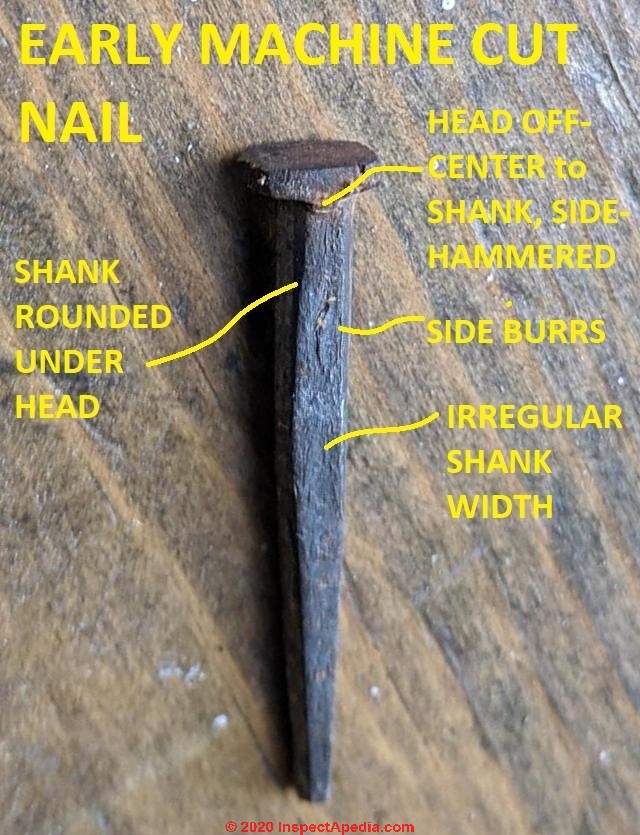
Really? The observation that the taper runs down 1/3 or more of the shank length argues that the above photo is actually of a "modern" machine cut nail, post 1830.
Also at our yellow line pointing out side burrs you'll see what may be a longitudinal split in the nail; if so the iron fibres run lengthwise not across the nail, also arguing for a "modern" cut nail (1835 - 1890) - Ed.
- After c 1835 - ca. 1890 "Modern" Machine-Cut Nails (in North America)
Nail shank: regular rectangle in cross section,
iron grains run along the direction of the nail shank or long-ways (nail can be bent over or clinched without breaking),
2 shank sides taper other 2 sides are parallel (cut from a flat blank),
Cutting machine leaves burrs on two edges of the same side of the nail (as the blank was not flipped-over to make a second side cut), i.e. the cut nail burrs show that cuts were from same side
Shank width is uniform / uniformly-tapered on both sides except that
Shank bevel under the head may extend 1/3 or more down the length of the shank
Nail head: machine-made, centered on the nail shank, or "concentric to the shank"
Cut nail heads produced on a one-operation machine are thicker than older generation, are regular in shape and size
Nail tip or end: square-cut
May have been used for clinching
Our photo below illustrates these cut nail features including splits along the shank length indicating the direction of the iron fibers. (Accordion lath nails in photo).
Antique cut-nails provided by an InspectApedia.com reader: two cutting/stamping burrs appear on the same side of the nail suggest the nail may have been made after 1840.
Photo below: the raised center rib along the shank tells us that this is a modern reproduction cut nail.
Photo below: machine made reproduction of an antique cut nail. Note the variation in shank diameter is irregular - the nail tapers below the head, then gets wider, then more-narrow to the nail tip. This was a machine cut boat nail.
Cut nail shanks that widen and then become more narrow again towards the point are dated by various sources as 1790 - 1820,
while cut nail shanks that taper at a uniform rate from under the head to the nail tip are generally dated as 1830 or later (in North America) or by some sources, 1810 or later. (Visser, U. Vt.)
More help: NAIL ID & AGE: HAND FORGED NAILS - using reproductions of antique cut nails by the Tremont Nail Co.
- 1850 & later: Modern round shank "wire" nails
More help: WIRE NAILS - 1950 & later: Modern nail-gun fasteners
Thin shank, small head, round or cut sides, bonded together for use in automatic pneumatic or electric or gas-powered nail guns, including construction nails, roofing nails, staples, and wire brads; small brads also fired from spring-loaded or electric tools.
...
Also see
- US NPS, Nelson, Lee H., NAIL CHRONOLOGY as an AID to DATING OLD BUILDINGS [PDF], U.S. National Park Service, Technical Leaflet No. 48. retrieved 2019/01/08, original source: http://npshistory.com/publications/nail-chronology.pdf
- Ryzewki, Krysta and Robert Gordon, HISTORICAL NAIL-MAKING TECHNIQUES REVEALED IN METAL STRUCTURE [PDF] Historical Metallurgy 42(1) (Jan 2008 pp 50-6), retrieved 2020/07/15, original source: www.academia.edu/1308787/Historical_nail-making_techniques_revealed_in_metal_structure?auto=download
Abstract:
Characteristics diagnostic of manufacturing technique are retained in the microstructure of iron nails even though the original surfaces are lost in corrosion.
Distinctive metal structures differentiate hand-forged and machine-made nails.
The one-operation machines that automatically cut and headed nails left unique shear bands in the nail-head metal. Presence of these shear bands indicates that nails cut and headed by machine were in use in Rhode Island before 1781.
Before about 1815 nail machines in New England operated on pre-heated iron plate, as shown by the recrystllization of the shear band.
Nails made thereafter until about 18509 were formed from cold iron and have un-recrystallized shear bands.
Cut nails made after about 1850 are in the longitudinal rather than transverse orientation [of iron fibres or crystals - Ed.], and have a folded head structure resulting from improved design of the nail machine header grips. - Visser, Thomas D., "Nails: Clues to a Building's History", [Web article] University of Vermont, Adapted from A Field Guide to New England Barns and Farm Buildings by Thomas D. Visser, published by the University Press of New England. For further information contact: tvisser@uvm.edu retrieved 2020/07/15 original source: https://www.uvm.edu/~histpres/203/nails.html
Offers a succinct guide to several types of nails with an aging key.
...
Reader Comments, Questions & Answers About The Article Above
Below you will find questions and answers previously posted on this page at its page bottom reader comment box.
Reader Q&A - also see RECOMMENDED ARTICLES & FAQs
On 2023-09-11 by LJW
Hi!
I found this today on the beach in Cancale, France.
To me it looks like a nail or so, but have no experience at all with this.
The body looks a little square and the head round, but it is covered with rock/minerals.
Do you have any idea what it could be or suggestion how to clean it properly without breaking it?
Much appreciated!
On 2023-09-11 by InspectApedia Publisher (mod) - cleaning up a possibly-bronze metal artifact from Cancale, France
@LJW,
The color of the "growth" on the head of that spike suggests that it may be made of bronze. If so it's probably quite old, and there won't be a fibre direction. If it's iron, as may be evident when it has been cleaned, then that may offer a clue.
Start with a week long soak in household vinegar.
Our best and most complete advice are in the steps given on this page.
In essence, as you’ll read above, when estimating the age, properties, use, and history of a metal fastener like a nail, spike, or screw, we look at
1. the item itself for clues about how it was made, of what materials, and in some cases iron fibre direction that can bracket age of manufacture
2. contextual clues: what we know from surrounding materials, location, history of the area, etc.
It would be worthwhile to review our steps above to help answer your question. As far as cleaning it, for more detail, please see
NAIL & HARDWARE CLEAN-UP (live link in our Recommended Articles list on this page)
On 2023-08-09 y Keiran - iron fastener / nail / spike from Beach in Wales
We found this on a beach in Wales. It was encrusted and when we took ot out of the casing, it looks like a metal spike or nail? It looks handmade, not machined
When we found it, it looked like it had markings on it
On 2023-08-10 by InspectApedia DF (mod)
@Keiran,
Our best and most complete advice are in the steps given at the top of this page. Please start there and let me know what you think of the results.
You may also want to take a look at
CHRONOLOGICAL HISTORY OF NAILS
https://inspectapedia.com/interiors/Nails_Hardware_Age.php
On 2023-07-28 by Phalen
Found this on beach. Any ideas?
Found this on a beach in Georgia. It definitely has nail head. The rest of it is blob of metal. I was in the Navy for a while so it was pretty cool to find it. I just wish I knew its purpose.
On 2023-07-28 by InspectApedia Publisher (mod)
@Phalen,
That's really interesting chunk of metal but it's such an odd shape that I'm not sure what it is.
Putting some context around finds like this can be very helpful in guessing if they're possible use and age. We give examples of that above.It looks almost like a wedge or shim.
On 2023-07-10 y Anonymous
I'm curious as to which these 5.5" inch spikes are, hand forged or machined, and approx. how old.
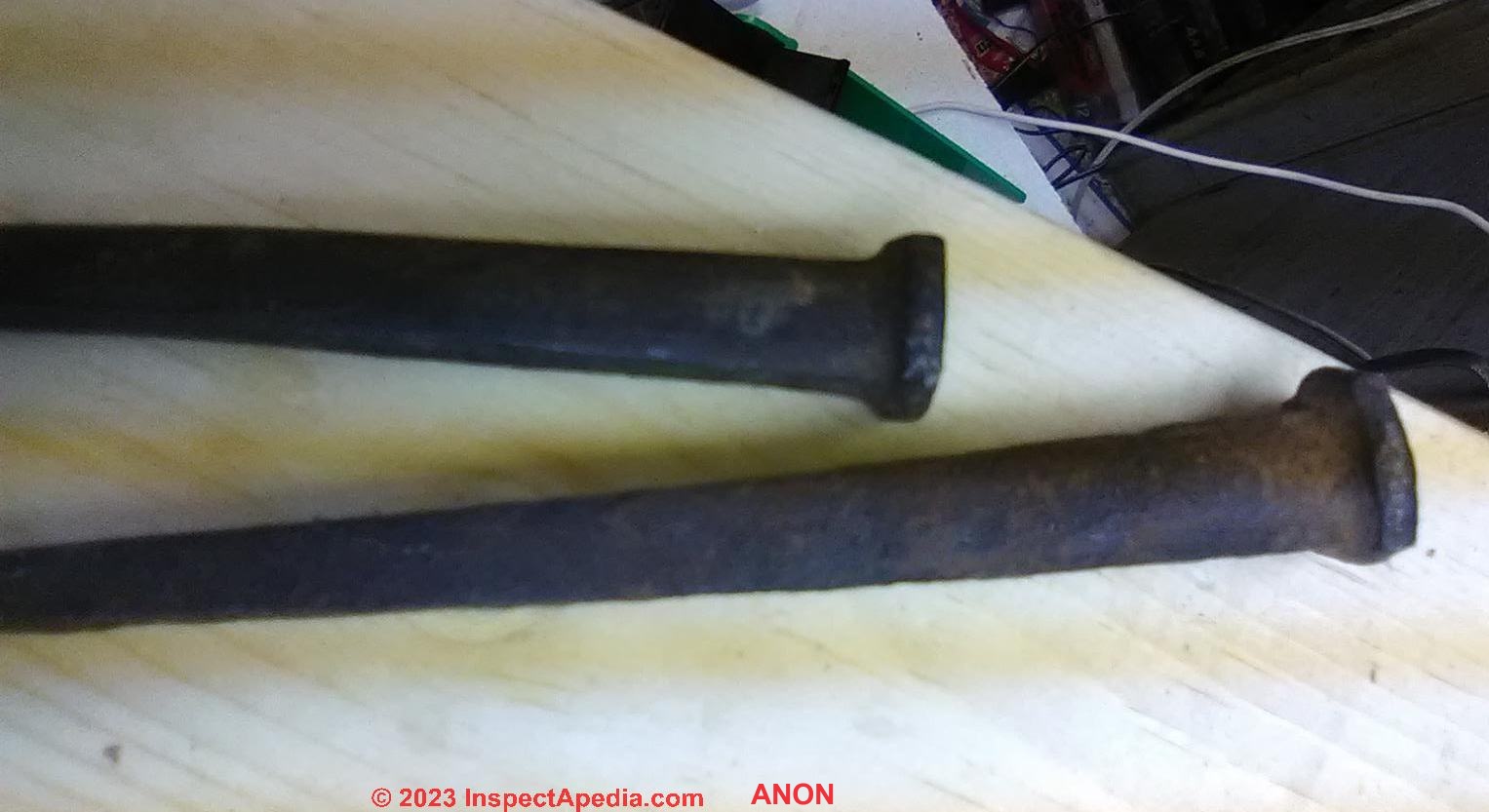
On 2023-07-10 by InspectApedia DF (mod)
@Anonymous,
Please take a look at the old nail and spike determination steps given above on this page.
When estimating the age, properties, use, and history of a metal fastener like a nail, spike, or screw, we look at
1. the item itself for clues about how it was made, of what materials, and in some cases iron fibre direction that can bracket age of manufacture
2. contextual clues: what we know from surrounding materials, location, history of the area, etc.
It's hard to tell from your photo if the shank is round or square or rectangular, or what the shape of the nail head is. Please do take a look at the information above on this page to help you with your questions.
On 2023-06-05 by Lora
Found this on the Westcoast of Canada - Pacific Ocean. Any ideas what it is? I tried to take a few photos up close to help with a soother for scale.
On 2023-06-07 by InspectApedia Publisher (mod) - possible early iron necklace or bracelet, early Canadian West Coast peoples
@Lora,
I wondered if that was some type of sale edge or luff weight but honestly I don't know. It looks almost like a piece of homemade jewelry using iron.From the scale offered by that baby pacifier I'd guess an early iron ornamented necklace.
Notice that there are a few details worked into the iron that show in your close-up photos.
Keep in mind that if we go back to pre-European times iron was often found at the ground surface and treated as a precious metal.
I'd suggest having this piece checked out by some museums who are familiar with the history of Canadian west coast peoples.
A starting place is the Canadian Museum of History at historymuseum.ca/cmc/exhibitions/archeo/hnpc/npvol28e.html
and by excerpt from that page
o acquire some appreciation of the exceptional cultural and linguistic diversity of the people of the British Columbia coast it is recommended that the reader consult Volume 7, Northwest Coast, Handbook of the North American Indians. Particularly useful introductory chapters are those by Wayne Suttles 1990 1990a .
On 2023-05-26 by Erik Davis
I found an early canvas oil painting of Alexander Hamilton and pulled one of the nails from the stretcher board, I need help identifying the age of this nail to help maybe put a time line on the painting.
Is it early to mid 19th century or earlier. Thanks!
On 2023-05-26 by InspectApedia DF (mod)
@Erik Davis,
I agree that that looks like an antique tack. Keep in mind that tacks were among the very first fasteners to be made by machine.
But the very sharp point and angular cut lead me to think this is a more-modern tack than the age of the frame and artwork.
When estimating the age, properties, use, and history of a metal fastener like a nail, spike, or screw, we look
1. at the item itself for clues about how it was made, of what materials, and in some cases iron fibre direction that can bracket age of manufacture
2. at contextual clues: what we know from surrounding materials, location, history of the area, etc. In your case, one note the point out is about looking at the surrounding frame.
Also take a look at our
CHRONOLOGY HISTORY OF NAILS
https://inspectapedia.com/interiors/Nails_Hardware_Age.php
And see the related articles in the Recommended Articles list found near the end of this page.
On 2023-05-21 by Matt kile
Found this while out metal detecting near an old Civil war site. Wondering if it is a nail or some sort of hook.
On 2023-05-21 by InspectApedia DF (mod)
@Matt kile,
From what we can see, it does seem to be a hook or fastener of some sort. The shadow shows the angle at which the 'head' is attached to the hook, and we appreciate the penny for size.
As you can read above on this page, the contextual clues around a found nail or spike can often give good information as to the item's identity and use.That perfectly-round shank suggests that this is a more-modern hook/nail manufactured from drawn wire, not hand forged.
On 2023-04-24 by Sashabot
Is there any significance to the fact that so much rock has built up around this iron tool?
I found these on a beach in Southern California. They were completely covered with rock I had to chip a way to find oh what was under it
On 2023-04-24 by InspectApedia Editor - mineral build-up on old rusty spikes from Southern California beach
@Sashabot,
Thanks, those are interesting photos of old spikes or nails.
What is the geology of the area where they were found? Is that simply a mineral build-up around the nails? It sure looks like a concrete mixture.
I can't see enough of the metal objects to have an opinion of what was their intended or original use, but in some of the photos it looks as if we're seeing flat-rectangular metal shanks that may be a clue to age and use.
On 2023-04-22 by Kim
Found this in the yard...I live in an area with older homes...1800s. Any idea what the purpose of the nail shape would have been?
...
On 2023-04-22 by InspectApedia Editor - framing nail bent into a hook by intention or not
@Kim,
Looks like a framing nail bent into a hook, either for use as a hanger or simply bent during withdrawal.On 2023-05-08 by SilentlessK
@Kim,
I'll wager the nail was once straight in a piece of wood and was curled when pried out with a cat's paw.On 2023-05-08 by InspectApedia Editor
@SilentlessK,
Agreed that that's a real possibility.
Thanks for your input.On 2023-05-08 by SilentlessK
@InspectApedia Editor ,
I'm a handyman in the DC area. Still lots of 100yo + properties around, like my grandparent's house built 1870s, tucked away in the suburbs. Had stumbled into this site before, but really just started digging deep into this is compendium of aggregated wisdom.Super nerdy.
Thanks
kOn 2023-05-08 by InspectApedia Editor
@SilentlessK,
Thanks for the nice comment and for not hanging out "silently". I was a nerd myself for a long time.
"Nerdy" where I [DF] come from can be a compliment: attentive to thoughtful research and refusing to spout bluster and baloney for clicks.
But here we're interested in real-world problem-solving for building structures, mechanical systems, and the building indoor environment.
And we work hard to give practical, researched, useful answers.
It ain't just bent nails & unicorns. But bent nails and tool marks on wood can tell us a lot about how buildings were and are put together, and what works, and what lasts, and what doesn't.
When I learned, working on repairing old houses, that I could look at a hammer mark and realize that I could stand exactly where stood the framer, 175 years ago, and swing my hammer in the same arc that she or he did, that thought gave me not just a sense of connection to the people who built or fixed homes before us, it was also a source of helpful humility.
So to that end, we'd sure be grateful for any hands-on, thoughtful or even nerdy information that you can add or for any questions or criticism or content suggestions for InspectApedia.com - working together can help us all, nerds and carpenters, forensic engineers and house painters. - DF
On 2023-03-08 by Angela
I found this in my backyard in Galena Missouri. I cannot find anything similar
On 2023-03-08 by InspectApedia Editor - large square-shank spike in Missouri
@Angela,
Thank you for the photo of what looks like a large square-shank spike - it's quite corroded and doesn't offer much more information than its size and shank shape, so you'll want to consider the surrounding context in which it was found.
On 2023-01-23 by LoriP
I found this on the beach on Vancouver Island, Canada, with a non-fully formed rock around it. It is roughly 3.5" long and less than .5" in width. There is no head (broke off?), and forms a flat tip/point which is the same width as the spike itself. Any ideas?
On 2023-01-23 by InspectApedia Editor - Vancouver Island spike with parallel fibers means it's machine-made
@LoriP,
The fibers seem to run parallel to shank which would mean a machine-made cut nail or spike.
Our best and most complete advice are in the steps given at the top of this page.
In essence, as you’ll read above, when estimating the age, use, and history of a a nail or spike, we look
1. at the item itself for clues about how it was made, of what materials, and in some cases iron fibre direction that can bracket age of manufacture (discussed more above in this article)
2. at contextual clues: what we know from surrounding materials, location, history of the area, etc.
On 2023-01-16 by PAD
...
Continue reading at NAIL ID & AGE: HAND FORGED NAILS or select a topic from the closely-related articles below, or see the complete ARTICLE INDEX.
Or see NAILS & HARDWARE, AGE FAQs - questions & answers posted originally at this page and additional photos of old and newer nails
Or see these
Recommended Articles
- AGE of a BUILDING, HOW to DETERMINE - home
- DOOR HARDWARE AGE
- FRAMING MATERIAL AGE
- NAILS, AGE & HISTORY - home
- HORSESHOE & HORSESHOE NAIL AGE
- NAIL & HARDWARE, AGE RESEARCH
- NAIL & HARDWARE CLEAN-UP
- NAIL AGE DETERMINATION KEY - use this key to guess at the age of your nail or spike
- NAIL ID & AGE: CUT NAILS
- NAIL ID & AGE: HAND FORGED NAILS
- NAILS in BARTER & TRADE
- NAIL SPLITS & CRACKS vs AGE
- NAIL TYPE, ANTIQUE, IDENTIFICATION KEY
- RAILROAD SPIKES
- RAILROAD SPIKE AGE - CONTEXTUAL CLUES
- SAW & AXE CUTS, TOOL MARKS, AGE
- WINDOW HARDWARE AGE
Suggested citation for this web page
NAIL AGE DETERMINATION KEY at InspectApedia.com - online encyclopedia of building & environmental inspection, testing, diagnosis, repair, & problem prevention advice.
Or see this
INDEX to RELATED ARTICLES: ARTICLE INDEX to BUILDING AGE
Or use the SEARCH BOX found below to Ask a Question or Search InspectApedia
Ask a Question or Search InspectApedia
Try the search box just below, or if you prefer, post a question or comment in the Comments box below and we will respond promptly.
Search the InspectApedia website
Note: appearance of your Comment below may be delayed: if your comment contains an image, photograph, web link, or text that looks to the software as if it might be a web link, your posting will appear after it has been approved by a moderator. Apologies for the delay.
Only one image can be added per comment but you can post as many comments, and therefore images, as you like.
You will not receive a notification when a response to your question has been posted.
Please bookmark this page to make it easy for you to check back for our response.
Comments















IF above you see "Comment Form is loading comments..." then COMMENT BOX - countable.ca / bawkbox.com IS NOT WORKING.
In any case you are welcome to send an email directly to us at InspectApedia.com at editor@inspectApedia.com
We'll reply to you directly. Please help us help you by noting, in your email, the URL of the InspectApedia page where you wanted to comment.
Citations & References
In addition to any citations in the article above, a full list is available on request.
- In addition to citations & references found in this article, see the research citations given at the end of the related articles found at our suggested
CONTINUE READING or RECOMMENDED ARTICLES.
- Carson, Dunlop & Associates Ltd., 120 Carlton Street Suite 407, Toronto ON M5A 4K2. Tel: (416) 964-9415 1-800-268-7070 Email: info@carsondunlop.com. Alan Carson is a past president of ASHI, the American Society of Home Inspectors.
Thanks to Alan Carson and Bob Dunlop, for permission for InspectAPedia to use text excerpts from The HOME REFERENCE BOOK - the Encyclopedia of Homes and to use illustrations from The ILLUSTRATED HOME .
Carson Dunlop Associates provides extensive home inspection education and report writing material. In gratitude we provide links to tsome Carson Dunlop Associates products and services.


